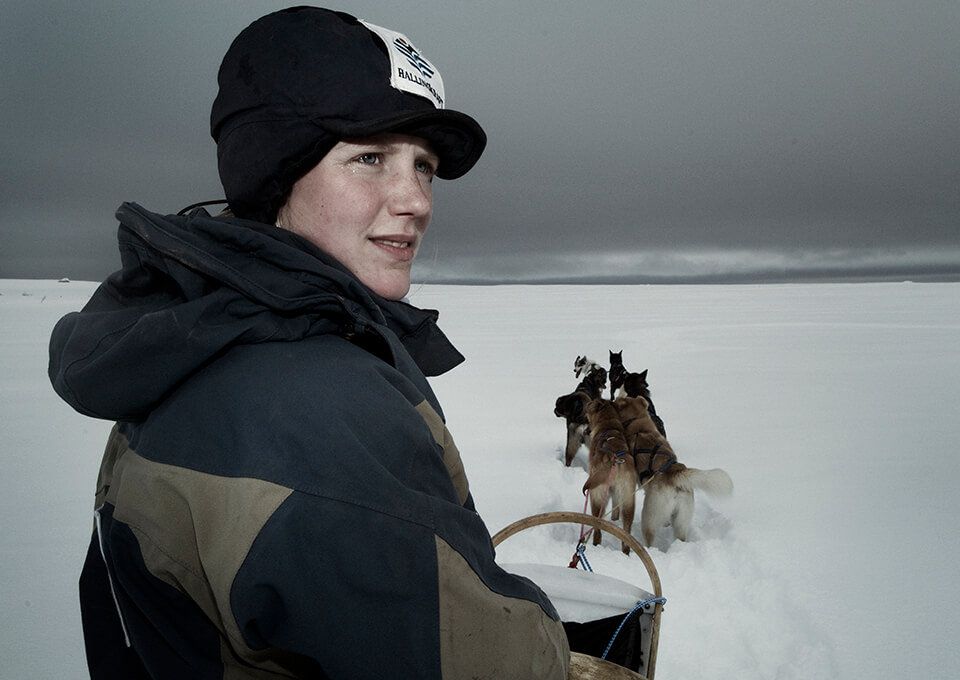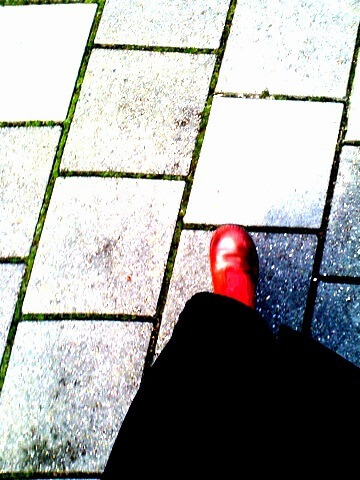The days that huskies played their part in polar expeditions are long gone. However, sled dogs are still driven on long journeys. We went in search of a modern musher and landed in the sleds of Norwegian marathon winner Elin Nordheim–Skarpås and dog lover Jarle.
Jarle’s story was told to the photographer. Both of us sat for hours on a reindeer skin in a husky sled. While she takes pictures of the huskies on the snow plains high in the Norwegian mountains, Jarle tells his story standing on his sled. About the love he feels for his dogs. About his sadness when he has to have them put down.
Husky musher
Elin Nordheim–Skarpås shares this love. She is a talented young Norwegian husky musher who won the Gausdal marathon last year with six of her own dogs and two she borrowed from Jarle. She had just turned 23 when she slid over the finish line in first place.
The seven dogs covered 100 kilometres in 7 hours and 39 minutes. An impressive performance because dog number eight was injured and had to be transported in the sled.
Marathon
She is waiting for us at her little farmhouse. Still just a girl. But these days other mushers are willing to stand in line for this girl when she has puppies. Since last year her dogs guarantee victory, after all. She is wearing grubby dungarees, a fur-lined cap and thick waterproof shoes.
Shoes that are later replaced by lined boots made of reindeer skin. It’s important, because snow covers your feet for hours during a trip, which is why mushers always look as if they have no feet in photos.

Nomadic tribes originating in Siberia and Eskimos from Alaska were the first to make use of sled dogs. Three thousand years on, the dogs are still suitable for travelling long distances. And they can still manage with very little food.
Snow scooter
They live outdoors under severe conditions and sleep curled up in the snow with the tip of their tails covering their noses. Although the traditional work of huskies has been taken over by snow scooters and aircraft, the dogs are still indispensable for humans because they have an edge on technology: they have instincts.
While Elin mixes the chopped up remains of elk legs with water to make a bloody breakfast soup, the dogs pull on their chains in the snow. Standing in front of their own kennel, they all bark for attention. Four females and four males in various ranges of colours.
Blood soup
‘I accidentally came in contact with sled dogs three years ago,’ Elin begins, while she stoically stirs the blood soup that gives off a sickly smell. ‘I’ve been a dog lover all my life, but just in an ordinary way, like most people. At home, we had a dog that lay in front of the fire.
My parents treated me to a husky trip and I was completely sold on the experience. It’s to do with having an adventure alone with dogs and being part of nature. That was what got me’.
Finnmarksløpet
The soup is ready and the first bowl is for Wilma, a brown-and-white female who is watching calmly. She is the leader of the eight-dog team. ‘She is six and took part in the Finnmarksløpet. That is a journey of 1000 kilometres through the far North, which takes five to six days.
She was given to me because she got injured and a toe had to be amputated, which makes her unsuitable for marathons lasting more than one day. But she is fantastic because she teaches the young dogs everything’.
In love
Opposite Wilma, a young black male with a caramel-coloured mask, Storm, pulls wildly at his chain. The dogs quickly slobber up their breakfast. Only the husky Zanzibar sits sadly next to his bowl, without even casting a glance at it. ‘He’s in love’, laughs Elin. ‘The females are in season. Zanzibar is a charmer. He’s having a hard time and is love-sick’.
Once the dogs have finished eating, Elin untethers the males. Storm immediately jumps the photographer who only just manages to stop herself falling into the reindeer leftovers. I was told never to sit at the front of a husky sled, ‘because the dogs relieve themselves while they run and it flies past your ears’.
Dog harnasses
But the dogs do their business at various places in the grounds of the farm. Besides, in Elin’s sled you don’t have a choice; there is only room for one person. While the dogs shoot over the terrain, Elin unravels the coloured plastic lines of the dog harnesses, which will soon attach them to the sled.
A wooden sled and a modern titanium sled are lifted onto the roof of the van. She then grabs the dogs and loads them into pens in the back of the van. Afterwards, it is the females’ turn.
Alaskan Huskies
The van smells strongly of dog and is full of brightly coloured dog socks, the size of baby feet. ‘I don’t need those just now’, says Elin. ‘The dogs are Alaskan Huskies, a cross between a husky and a hound. This combination produces speed and warmth – like crossing a Harley with a fur coat. The dogs do best at a temperature of -15°C’. The thermometer in the car reads – 12°C.
‘You have a different relationship with these dogs than with a pet dog’, Elin tells us while she steers the van over the snowy road into the mountains. ‘It’s more intense. You do things together, go through new experiences. That creates a very special bond. You feel it and the dogs feel it, too’.
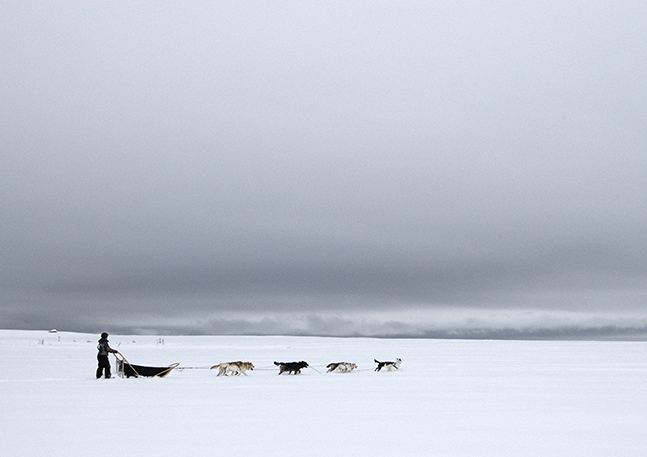
To take part in a race, the dogs have to be 18 months old and that means that Elin can’t include all her dogs yet. Twins Rapala and Spinner who do join the trip today, are only 9 months old and weren’t around when she achieved her victory.
‘Some people said I had won because as a woman I’m lighter, but that’s nonsense. I always practise with about 20 kilos extra feed in the sled. Because you also have baggage on long races’.
Or an injured dog, as happened to her during the race. And the animal has to go in the sled. ‘So I actually managed to win with more weight and less animal power’.
High in the mountains, she parks the van. The dogs throw themselves yelping against the bars. The sound is high-pitched and loud. Jarle, with whom she regularly makes trips, is already standing waiting for us with his 12 dogs.
Wooden sled
It is difficult to give orders above the sound of 20 wildly barking dogs, so Elin limits herself to non-verbal instructions. The wooden sled is lifted off the roof. To prevent the dogs from taking off with sled and all but without Elin once they are harnessed, she throws an anchor deep into the snow.
Once the dogs are harnessed, Elin fetches a reindeer skin that she lays in the sled. I take my place on the skin, inside the polyester sack. I am lying in the sled like a corpse in a body bag.
No sound
And then we weigh anchor and the pack makes a dash for it. Suddenly it’s quiet. Dead quiet. As if nature has become a vacuum, the huskies run silently through the snow behind Jarle’s pack. Elin is standing behind me on the sled giving orders in a soft voice to Wilma who forms the advance guard together with Ayla.
Her Wilma sounds like Veelna. The dogs’ tongues are hanging out of their mouths, but there is no sound of panting. We soon leave the path and come onto a white plain that conceals a mountain lake underneath.
Strong dogs
Zanzibar is right at the back of the pack, just in front of me, so he runs the entire journey in the scent of the ladies. That seems like a smart move, but it’s not the reason. ‘I need strong dogs at the back, who can pull more weight. It’s actually the heaviest position’.
Although we are gliding in a white world over white mountains, the trained eye can make out a path. Every so often, Elin calls a dog’s name. Ears are pricked for a moment. ‘Good girl Nola, you’re doing fine’, you hear her say. And then the sled has to make room for the postman.
Postman
The oncoming driver is our complete opposite in every respect. Dressed in black, the man is sitting on a bright red snow scooter that banishes the white silence with a roar.
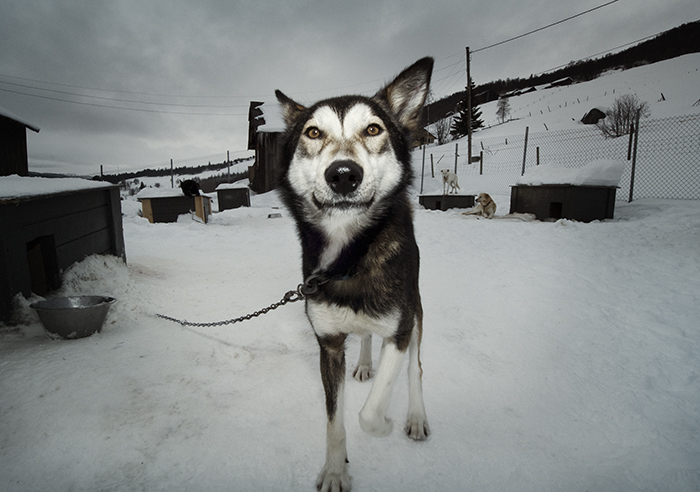
For a while, it looked as if snow scooters would make the sled dog completely redundant, but now that climate change is making natural elements such as polar ice unreliable, people are trusting the instincts of animals once more.
Polar regions
In polar regions, the dogs can sense unsafe ice. But climate change also makes mushers concerned. ‘You notice that we get less snow every year, that worries us. Climate change has become tangible’, says Elin.
Once the postman has disappeared, the dogs take up their silent rhythm once again. There is no audible labouring. ‘They are happy’, says Elin as if she has read my mind. ‘Look at Ayla, her ears are upright. She is contented’. Ayla is leaning against Wilma a little at the bends and Elin makes a mental note to harness the dog on the other side next time. ‘Otherwise she’ll develop a crooked run’.
Mushing
Elin asks if I would like to mush. We stop and the dogs drop flat into the snow, while they snap with their muzzles deep in the snow. I take up position on the narrow wooden runners. A black rubber mat connects the wood, behind an iron crossbar with serrated edges that reminds me of a trap.
‘The soft and the hard brake’, explains Elin. ‘If we are going downhill, the soft brake is used to prevent us overturning’.
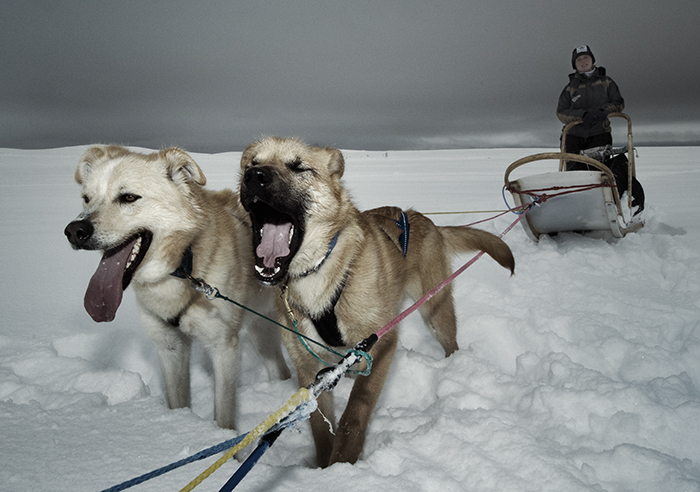
While I am gingerly testing my balance with my clumsy boots on the wooden strips, the pack leaps into action behind Jarle’s pack. There is no whoa that will help now. The dogs have gone crazy and shoot through the snow.
Black-and-white landscape
I feel like an extra in a silent film shot in a black-and-white landscape. The sky is so grey it is almost impossible to imagine that white flakes could fall out of it.
For hours we glide in silence. The cold sticks to my cheeks. Where the sled pushes its way through the snow, my legs form an obstacle and snow heaps up to my knees. My feet have lost all feeling. Wherever I look, there are only white hills and white plains. Colour has been leached out of the landscape.
Scot and Amundsen
In my mind, I slip backwards in time. I see how the explorers Scott and the Norwegian Amundsen raced to the South Pole a century ago with the help of sled dogs. Ultimately it was the Brit who tasted defeat. Amundsen wrote in his journal that he had 24 dogs killed to provide food for the rest of the sled dogs.
On 14 December 1911, the Norwegian was first to reach the South Pole, with 16 dogs. From my sled, I can see how he planted the flag.
South Pole
Fortunately, no dogs perish on this journey. There are no whips thrashing the dogs until they bleed, only Elin’s soft voice giving them fresh heart. When we are back at the van, we take our leave of each other. Elin is going to make another journey with the titanium sled to train for the marathon in January.
Wilma lets her warm head rest on my frozen leg for a moment, while Ayla licks snow from my cheek with her warm tongue. I pat Zanzibar for a moment through his thick coat and then it is quiet again. The pack has left.
Text: Anneke de Bundel – Images: Nicole Franken
Translation: Christine Gardner
This story was nominated for the 2012 Aad Struijs Press Award for travel features and has been published in travel magazine Meridian Travel. This story has also been published in Dutch in our book On fairies and bullet holes. You can order our book here.
More Norway? Have a look at:
- The Norwegian moonlanding
- The aquarium and more Norwegian love affairs
- Hurtigruten in the picture
- North Cape in the picture
Norway practical
- Hallingdal where this took place can be reached by train.
- From Oslo an oldfashioned train goes to Bergen. Get out at Ål station.


